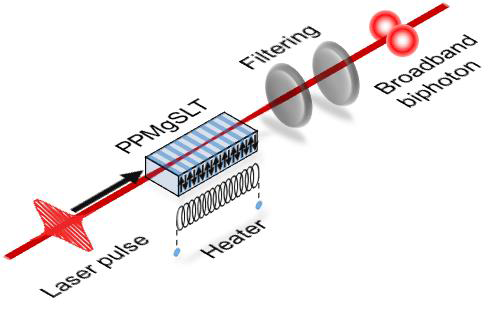Understanding spectral properties of broadband biphotons

Advances in quantum optical technologies require scientists to control and exploit the properties of so-called biphotons. Biphotons occur when two photons become 'quantum-entangled' - spatially separate entities whose individual quantum states must be described with reference to each other. Biphotons of different wavelenths can be created, with broadband biphotons particularly useful for quantum optics.
Now, Nandan Bisht and Ryosuke Shimizu at the University of Electro-Communications in Tokyo, Japan, have successfully generated broadband biphotons using a strong laser pulse beam shone through a so-called PPMgSLT crystal, and examined their associated spectral properties and interference patterns.
This method of generating biphotons is known as spontaneous parametric down-conversion (SPDC). Most photons from the laser pass straight through the crystal. Occasionally random pairs of photons appear within two defined cone-shaped trajectories - one cone comprising horizontally-polarized photons, the other carrying vertically-polarized photons. At the point where the 'cones' meet, the photon pair trajectories exist simultaneously and the photons become entangled, creating 'biphotons'. This technique allows scientists to create highly specific optical fields.
Previous attempts at generating broadband biphotons with thin crystals led to a loss of brightness in the resulting optical field. Using the PPMgSLT crystal, Bisht and Shimizu successfully generated broadband biphotons with a spectral width of over 40 nanometers. Their tests showed that the spectral properties of biphotons appeared to be mainly determined by the spectral properties of the chosen laser pulse. The team hope that properties of biphotons could be deliberately controlled to improve optical fields for future quantum information and communication technologies.
More information: Bisht, N.S. & Shimizu, R. "Spectral properties of broadband biphotons generated from PPMgSLT under a type-II phase-matching condition." Journal of the Optical Society of America 32 (4) (2015)
Provided by University of Electro-Communications


















